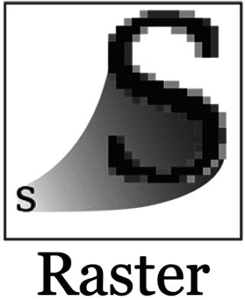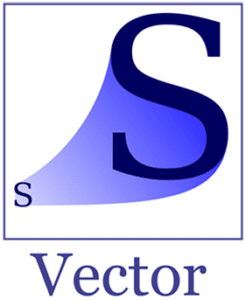Regular users of Scan2CAD will know that one of the strengths of the software is the large number of file types it supports. In fact, Scan2CAD supports no fewer than 33 different file types. What are the differences between these file types, and when should you use them? This quick guide will tell you everything you need to know.
Scan2CAD supports a range of both raster and vector image file formats. Most of these formats are able to be both loaded into and exported from Scan2CAD. To find out which is which, follow this handy key:
| L | Loading supported |
| L | Loading not supported |
| E | Exporting supported |
| E | Exporting not supported |
Raster file types
Raster images are made up of pixels, and are commonly used for photographs and on websites. If you’d like to learn more about raster images, check out our user manual.
Scan2CAD supports a large number of raster file types. However, there are certain formats which are better suited to conversion than others. This is because different file types use different types of compression – either lossy or lossless.
- File types which use lossy compression lose quality when saved, but take up less hard disk space.
- File types which use lossless compression retain their quality when saved.
Raster Formats to Avoid – (Where possible)
- JPEG/JPG (or JPE): L & E One of the most popular formats for photographs, JPEGs should nonetheless be avoided where possible when converting a raster image to a vector. This is because of its lossy compression, which can make it lose its quality. Check out our previous post on JPG problems.
Still need to convert your JPEG file? Check out our ultimate guide to JPG to DWG conversion.
- GIF: L & E This popular format should also be avoided where possible. Whilst GIF uses lossless compression, its resolution is usually so low that the noise will cause problems for successful vectorization. If you still need to convert a GIF, check out our ultimate guide to GIF to DXF conversion.
More Suitable Raster Formats
The best formats for vectorization generally have a few things in common. They support high-quality images, have an appropriate resolution, and allow for lossless compression.
- TIF/TIFF: L & E TIFFs support high-quality images, and offer lossless compression. They are seen as the gold standard in graphic design and photography, and are suitable for conversion. Scan2CAD also supports GeoTIFF, which allows users to embed geographic data.
Learn how to convert from TIFF to DWG or DXF in our ultimate guides.
- BMP: L & E Bitmaps can either be compressed or uncompressed. Both versions may have a tendency to take up a lot of hard disk space but that’s not necessarily a problem considering the ever-reducing price of storage. An uncompressed BMP will be high quality. To vectorize your image, check out our pro tips to convert BMP to DXF.
- PNG: L & E Whilst PNGs aren’t quite as high-quality as TIFFs, they are more widely-supported, especially by web browsers. PNG is typically of much higher quality than JPEG, and supports lossless conversion. It also has alpha layers, allowing for transparency within the image. As such, PNG is a great format for vectorization. For more information, check out our PNG to DXF Ultimate Guide.
Other Raster Formats
- CALS: L & E This is a less common format, commonly used by the military. Its extensions include .cal, .cg4, .cit, .gp4, and .mil. There are two types of CALS, Type 1 and Type 2. Scan2CAD supports Type 1, which is one image only and uses lossless compression.
- JPEG 2000: L / E This format was created to improve upon the existing JPEG format. It has a higher compression ratio, and supports both lossy and lossless compression. However, it has remained a relatively uncommon format. File extensions for JPEG 2000 include JP2, J2C, J2K, and JPT.
- IMG: L & E First developed in 1985, IMG is one of the oldest image formats around. An IMG file can either be saved uncompressed, or using lossless compression.
- PCX: L & E This is a rarely-used format, having been superseded by more sophisticated formats like PNG and BMP. It uses ‘lossless’ compression.
Vector File Types
Vector image files are extremely popular in engineering, CNC, graphic design and many other industries. They are made up of paths rather than pixels. From the user’s point of view; they are far easier to edit than raster images, and maintain their quality at any scale. However, some vector formats are more widely-supported than others. Read on to find out more…
Widely-Supported Formats
- DXF: L & E DXF was created to allow users to exchange drawings between different pieces of software. It’s essentially a ‘neutral’ vector format that is supported by almost all CAD programs on the market. For this reason, we usually recommend converting to DXF, especially if you’re working on a project collaboratively. For more information, visit our overview of DXF conversion.
- DWG: L & E This is the native file format for AutoCAD, the most popular CAD software on the market. It can also be used with many other CAD programs, though it isn’t quite as widely-supported as DXF. There are pros and cons to using both formats – check out our DWG vs DXF article.
- PDF: L & E PDFs are one of the most common file formats in the world. They can store both raster images (e.g. from scanning) and vector graphics (e.g. from CAD). PDF also has the advantage of being viewable on web browsers, unlike most CAD formats. To be able to edit a PDF, however, it must be converted to a CAD format, such as DXF or DWG. For more information on converting from PDF to CAD, check out our PDF-to-DXF conversion section, or look at our top tips.
Other Vector Formats
- SVG: L / E This format is based on XML, and is supported by all major web browsers. It allows for compression when using the .svgz extension.
- AI: L / E This is the native format of Adobe Illustrator, a widely-used vector graphics editor. If you want to use an AI file outside of Adobe’s suite of software, you will typically need to save it as a DXF or DWG file.
- CNC/NC: L / E As the name suggests, this format is used in CNC machining. CNC files take vector paths, and convert them into instructions that machines are able to follow. Want to learn more about CNC? Check out our list of five new innovations in CNC.
- Windows Metafile: L / E Windows Metafiles (.wmf) were created to be used across a range of applications, and can support both raster and vector graphics. There are also Enhanced Metafiles (.emf), which are used for printing in Windows.
- HPGL: L & E Designed by HP, this format was created to send plotting instructions to printers. File extensions include .hpgl, .hgl and .plt.
- TAP: L / E This format is typically linked to Geopath CAD software, as one of its default file types.
Want to find out more? Discover more information about these file types and their extensions.
Scan2CAD’s huge range of supported file types is just one of its many advantages. Equipped with OCR and a full image editing suite, it’s easy to see why Scan2CAD is the market leader in vectorization. Want to try it for yourself? Get it all with our 14 day free trial.

